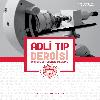Iskeletleşmiş Cesetlerde Postmortem Interval Tayini
Postmortem Interval in Skeletonized Body
___
- 1. Jans MM. Microbial bioerosion of bone--a review. In: Wis-- shak M, Tapanila Eds. Current Developments in Bioerosion. Berlin: Springer Verlag, 2008:397--413.
- 2. Kellerman G, Waterman N, Scharefenberger L. Demon-- stration in vitro of postmortem bacterial transmigration. Am Clin Pathol1976;66[5]:911--5.
- 3. Bell LS, Skinner MF, Jones SJ. The speed of post mortem change to the human skeleton and its taphonomic signifi-- cance. Forensic Sci Int 1996;82[2]:129--40.
- 4. Marchiafava V, Bonucci E, Ascenzi A. Fungal osteoclasia: model of dead bone resorption. Calc Tiss Res 1974;14[1]:195-- 210.
- 5. Hackett C. Microscopical focal destruction [tunnels] in ex-- humed human bones. Med Sci Law 1981;21[4]:243--65.
- 6. Yoshino M, Kimijima T, Miyasaka S, Sato H, Seta S. Micro-- scopical study on estimation of time since death in skeletal remains. Forensic Sci Int 1991 ;49[2]:143--58.
- 7. Swift B. The timing of death. In: Rutty GN ed. Essentials of Autopsy Practice. London: Springer--Verlag. 2006:189--214.
- 8. Knight B. Methods of dating skeletal remains. Med Sci Law 1969;9[4]:247--52.
- 9. Jarvis DR. Nitrogen levels in long bones from coffin buri-- als interred for periods of 26--90 years. Forensic Sci Int 1997;85[3l:199--208.
- 10. Knight B, Lauder I. Practical methods of dating skeletal remains: preliminary study. Med Sci Law 1967;7[4]:205--8.
- 11. Knight B, Lauder |. Methods of dating skeletal remains. Hum Biol1969:322--41.
- 12. Saukko P, Knight B. Knight's Forensic Pathology. London: Edward Arnold Publishers, 2004.
- 13. Buchan M, Anderson G. Time since death: review of the current status of methods used in the later postmortem inter-- val. Can Soc Forensic Sci 2001;34[1]:1--22.
- 14. Hoke N, Grigat A, Grupe G, Harbeck M. Reconsideration of bone postmortem interval estimation by UV--induced autofluo-- rescence. Forensic Sci Int 2013;228[1]:176.e1--e6.
- 15. Forbes SL. Potential determinants of postmortem and postburial interval of buried remains. In: Tibbet M, Carter DO eds. Soil Analysis in Forensic Taphonomy: Chemical and Bio-- logical Effects of Buried Human Remains, Boca Raton: CRC Press, 2009:225--46.
- 16. Pollard A. Dating the Time of Death. In: Hunter J, Roberts CA, Martin eds. Studies in Crime: Arı Introduction to Forensic Archaeology. London: BT Batsford Publishers, 1996:139--55.
- 17. Introna F, Di Vella G, Campobasso CP. Determination of postmortem interval from old skeletal remains by image analysis of luminol test results. Forensic Sci 1999;44:535--8.
- Lale A. et al. Postmortem Interval in Skeletonized Body 18. Ramsthaler F, Kreutz K, Zipp K, Verhoff M. Dating skeletal remains with Iuminot--chemiluminescence. Validity, intra--and interobserver error. Forensic Sci Int 2009;187[1]:47--50.
- 19. Brandt E, Wiechmann |, Grupe G. How reliable are immu-- nological tools for the detection of ancient proteins in fossil bones? Int Osteoarchaeol 2002;12[5]:307--16.
- 20. Schwarcz HP, Agur K, Jantz LM. new method for deter-- mination of postmortem interval: citrate content of bone*. Forensic Sci 2010;55[6]:1516--22.
- 21. Taylor R, Suchey J, Payen L, Slota P. The use of radio-- carbon [14C] to identify human skeletal materials of forensic science interest. Forensic Sci 1989;34[5]:1196--205.
- 22. Cook GT, MacKenzie AB. Radioactive isotope analyses of skeletal materials in forensic science: review of uses and potential uses. Int Legal Med 2014:1--14.
- 23. Haglund WD. Dogs and coyotes: Postmortem Involvement with Human Remains. Boca Raton: CRC Press, 1997: 367--81.
- 24. Haglund WD, Reay DT, Swindler D. Tooth mark artifacts and survival of bones in animal scavenged human skeletons. Forensic Sci 1988;33[4]:985--97.
- 25. Morse D, Dailey R. The degree of deterioration of associ-- ated death scene material. Forensic Sci 1985;30:119--27.
- 26. Cardoso H, Santos A, Dias R, Garcia C, Pinto M, Se'rgio C, Magalhâes T. Establishing minimum postmortem interval of human remains in an advanced state of skeletonization using the growth rate of bryophytes and plant roots. Int Legal Med 2010;124[5]:451--6.
- ISSN: 1018-5275
- Yayın Aralığı: 3
- Başlangıç: 1985
- Yayıncı: BAYT Yayıncılık
iki Olgu Nedeni Ile Sabunlaşma
Nergis CANTÜRK, Gürol CANTÜRK, Sait ÖZSOY, Birol DEMİR
Çocuk cinsel istismarında çocuk oyunlarının aracı olarak kullanımı, bir olgu sunumu
Yakup ÖRS, Oğuzhan YAKUPOĞLU, Sait SARIÇİÇEK, S.Salih ZOROĞLU
Fraktür mü, Anatomik Varyasyon mu?
Mehmet Sunay YAVUZ, Yıldıray ZEYFEOĞLU, Tarık ULUÇAY, Muhammed Ziya KIR, İlknur KAHRAMAN
The Reasons for Issuing Writ at Forensic Document Investigation
Bahadir KUMRAL, Muhammet Nabi KANTARCI
Iskeletleşmiş Cesetlerde Postmortem Interval Tayini
Ramazan AKÇAN, Aykut LALE, Ali Rıza TÜMER, Eyup Ruşen HEYBET, Aysun Balseven ODABAŞI
Esra ÜNAL, Sadi ÇAĞDIR, Zafer ÇETİNKAYA, Süleyman YILMAZ, Volkan ÜNAL, Muhammede Fatih YILDIZ, Yalçın BÜYÜK
BCG Uygulama Hatası: İki Olgu Sunumu
Esra ÜNAL, Sadi CAĞDIR, Zafer ÇETİNKAYA, Humman ŞEN, Volkan ÜNAL, Özge YAŞLI
Fatih AKYÜZ, Gülay Özel CAVLAK, Ömer H.A. MÜSLÜMANOĞLU, Aybars TÜRKER, Ümit ÇETİNKAYA
Havacılık Yaralanmaları ve Adli Tıp
Mahmut Şerif YILDIRIM, Ramazan AKÇAN, Aykut LALE, Eyüp Ruşen HEYBET
